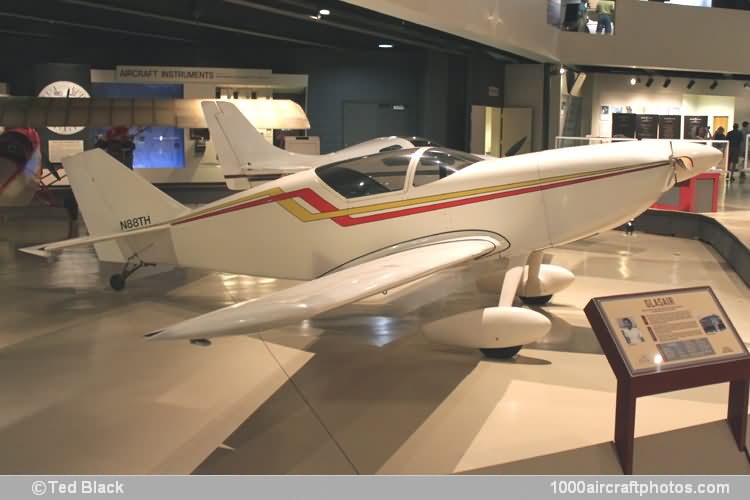07/31/2012. Remarks by Walter van Tilborg: "Designed by Thomas 'Tom' S. Hamilton, this is the prototype of the Glasair family which became one of the most popular homebuilt aircraft of the 1980s and 1990s. In 4.5 years it was developed from the discontinued SH-1 tandem two-seat prototype of 1975, it became the world's first pre-molded composite kitplane.
The kit has been produced by Stoddard Hamilton (1979 to 2000) and by Glasair (since 2001) in many versions, with the following types of landing gear: fixed tricycle gear (FT), retractable tricycle gear (RG), tail dragger (TD).
(July 21, 2012 it was announced that Glasair Aviation LLC was acquired by the Chinese Jilin Hanxing Group, and will continue operations as Glasair Aviation USA LLC.)
SH-2. Prototype (N88TH), 115 hp Lycoming O-235 engine, fixed tail wheel type landing gear, first flown 1979, received CofA August 10, 1979. Reportedly previously referred to as Hamilton HAM-2, after initial test flying referred to as Glasair, joined EAA Museum collection in 1986.
SH-2 Glasair I. Second prototype (N89SH), 150 hp Lycoming O-320 engine, many improvements including higher canopy, first flown late 1980.
SH-2 Glasair 160 (FT/RG/TD). Initial version, 160 hp Lycoming O-320 engine, first 160RG flown July 13, 1982.
SH-2 Glasair 180 (FT/RG/TD). Similar to 160 models, but with 180 hp Lycoming O-360 engine.
SH-2 Glasair Long (FT/RG/TD). Glasair 160 and 180 aircraft with 4ft (1.22 m) wing tip extensions.
SH-2 Glasair II (FT/RG/TD). Successor of 160/180 models, O-320 or O-360 engine up to 200 hp, slightly wider cockpit and easier modular kit construction, introduced in 1986.
SH-2 Glasair II-S (FT/RG/TD). Stretched fuselage, slotted flaps, prototype first flown 1989.
SH-2 Glasair Super II-S (FT/RG/TD). Increased length, wings slightly aft, the engine forward, larger horizontal tail, aerodynamic improvements, first flown 1993.
SH-3 Glasair III. Many developments, wider fuselage, stressed for engines up to 300 hp (usually Lycoming O-540), taller landing gear, first flown 1986. Sometimes referred to as Glasair IIIRG as it was only available with retractable gear.
SH-3 Glasair III Turbo. Turbocharged 300 hp O-540 engine.
SH-3 Glasair III-LP. Experimental aircraft, 300 hp Lycoming IO-540 engine, special built-in features to withstand lightning strikes. Used by Stoddard-Hamilton, in co-operation with NASA, in a lightning strike protection test program, first flown in 1993.
SH-3 Glasair Super III. Modified engine cowling, larger rudder, turbocharged 350 hp Lycoming IO-540, increased fuel capacity, more baggage area, first flown late 1998. Prototype was initially built for high-speed trials at altitude, later the Super III became available for amateur construction.
SH-3 Glasair III Turbine. Longer nose, longer span, longer ailerons, increased vertical tail area, 420 hp Allison 250 turbine engine. Built by Dave Becktold and Darrell Peterson of Composite Turbine Technologies, in 1994, development was later continued by Becktold Aviation. In 1997 Mike Manary built Glasair III with de-rated 724 hp Walter/LOM M601D turbine engine in a longer nose.
AT-9. Increased length and height, 420 hp Allison 2540-B17D turbine engine. Aerocet developed Glasair III variant for military trainer market, first flown July 24, 1988.
T-9 Stalker.Further development by Stoddard-Hamilton of sole AT-9, no production followed.
Turbine 250/III. Stoddard-Hamilton Glasair III turbine engine variant offered from 1995 onwards for amateur construction."
